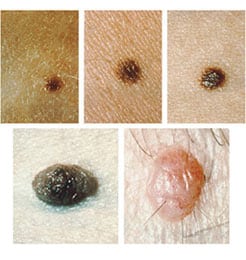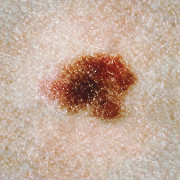Dysplastic nevi are atypical moles that may increase your risk of skin cancer. They vary in important ways from common moles.
What is Dysplastic Nevi (Atypical Moles)
Posted on September 6, 2015 in Skin Cancer

Written by Dr. Newman
Jump to section
What are common moles?
Common moles are small growths that appear on the skin. These growths are made up of melanocytes, which are pigment cells found in the epidermis that are responsible for producing skin color. When melanocytes grow in clusters, moles are produced. The scientific name for a common mole is nevus. The plural is nevi.
Most people have moles. According to the National Cancer Institute, adults typically have between 10 and 40 moles. Usually, moles are found above the waist and are often located in areas that are exposed to the sun. Rarely, moles may appear on the breast and buttocks.
Some people are born with moles, although they frequently develop during childhood. In most cases, common moles continue to form through middle age. When people reach the age of 40 or 50, the formation of new moles is less common, and moles tend to fade or may go away completely after middle age.
What do common moles look like?

Characteristics of common moles include:
- Size: 5 millimeters (1/4 inch) in diameter or smaller, roughly the size of a pencil eraser
- Shape: round or oval
- Texture: smooth surface
- Edges: distinct boundary between the edge of the mole and the rest of the skin
- Protrusion: slightly raised or domed-shaped
- Color: brown, pink, beige, or flesh-colored
What are dysplastic nevi/atypical moles?
A dysplastic nevus, also called an atypical mole, is a mole that looks different than common moles in certain ways. Dysplastic nevi can form anywhere on the body, but are often found in areas of the body that are frequently exposed to the sun. However, it is not uncommon for dysplastic nevi to form on the scalp, breasts, or legs. Most people with dysplastic nevi also have more common moles that usual.
What does a dysplastic nevus/atypical mole look like?

Characteristics of a atypical moles include:
- Size: typically larger than a common mole—greater than 5 millimeters (1/4 inch)
- Shape: shape may vary, but is usually asymmetrical
- Texture: may be pebbly, smooth, scaly, or rougher than common moles
- Edges: usually irregular and jagged, may fade in color around edges
- Protrusion: typically flat
- Color: may be a combination of several colors, from pink to dark brown
Can a dysplastic nevus turn into skin cancer?
What should I do about a dysplastic nevus/atypical mole?
Doctors recommend that people with atypical moles perform a self-check on their skin once a month.
What to look for:
- Changes in color, such as when a mole becomes darker or develops new colors.
- Changes is size, such as when a mole grows rapidly or becomes larger than the tip of a pencil eraser.
- Changes in texture, such as becoming hard or the development of a scaly, rough, pebbly, or dry surface.
- Changes in shape, particularly when the edges of a mole become irregular, jagged, or undefined.
If you notice any of these changes during a self-check, consult your doctor.
Should my doctor remove a dysplastic nevus?
Related Posts
All Topics
- Abstracts & Publications (1)
- Announcement (10)
- Brain Tumors (3)
- Breast Cancer (5)
- Cancer (24)
- Cancer news (3)
- Cancer Treatment Centers (1)
- Cancer Treatments (6)
- Colorectal Cancer (1)
- Featured (4)
- Lung Cancer (9)
- News (13)
- Oncology (4)
- Pancreatic Cancer (1)
- Prostate Cancer (9)
- Provider of the Month (40)
- Radiation Therapy (15)
- Research (2)
- SERO (2)
- Skin Cancer (30)
- Smoking (2)
- Survivorship (1)
- Tips (7)

